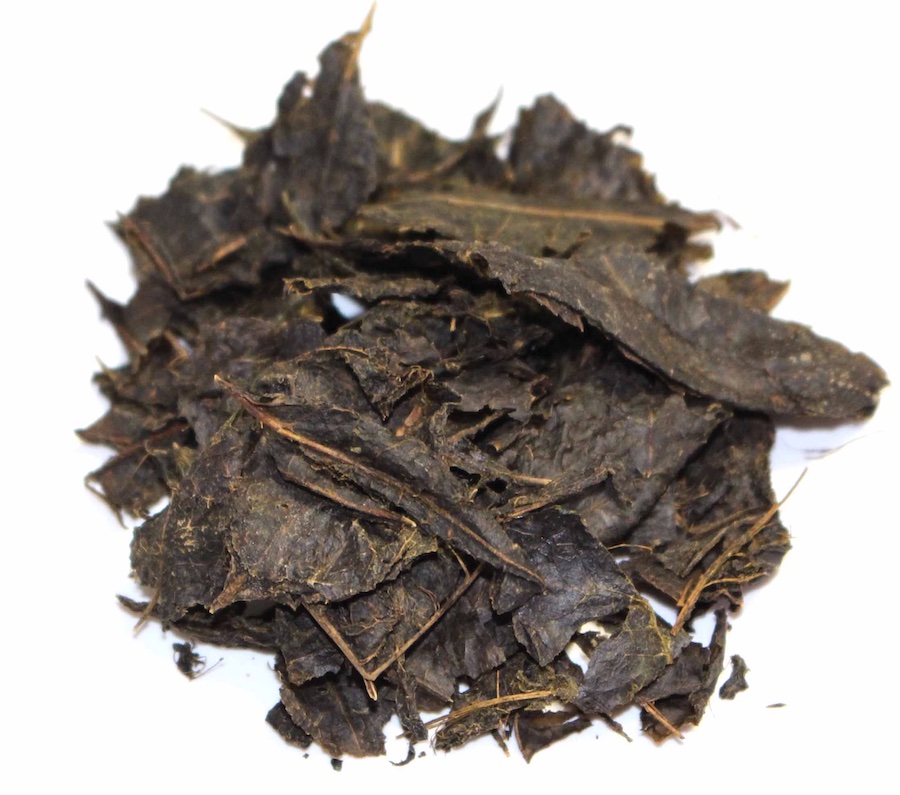MENU
MENU


Dark tea
Japan
Ishizuchikuro-cha (Ehime, Japan)
Tea is classified into six categories: green tea, white tea, yellow tea, blue tea (oolong tea), black tea, and dark tea. This site introduces the various teas that CHAMART has sampled.
Dark tea
Post-fermented tea
Ishizuchikuro-cha is post-fermented tea made in a two-stage fermentation process. The first fermentation is an aerobic fermentation using mold and the second fermentation is an anaerobic fermentation using lactic acid bacteria.
Production area: Seiyo City, Ehime Prefecture
Flavor: Ishizuchikuro-cha has a sharp sour acidic flavor. The flavor is matured by keeping the tea leaves in a dark and cool place for 2 or 3 years.
How to drink: According to the local people, the method for making Ishizuchikuro-cha is done by brewing the tea leaves in a kyusu (teapot) or boiling them in a pan of water. Either method is ok.

Producing Ishizuchikuro-cha at Satsukikai’s workshop (July 2019)
Photo provided by A Maruyama
Production method
1. Branches of tea plants with leaves are plucked from the end of June until the beginning of July. These are then washed and steamed in a large caldron for about 1 hour on the day of the plucking.
2. After the steaming, the tea leaves are removed from the branches and placed with the broth which was made from the steaming in a wooden bucket for approximately a week. Aerobic fermentation is then carried out by adding mold as the first fermentation.

Producing Ishizuchikuro-cha at Satsukikai’s workshop (July 2019)
Photo provided by A Maruyama
3. The tea leaves are removed from the wooden bucket and rolled on a wooden washboard in order to scratch the tea leaves. The scratches then promote the second fermentation. They are next put inside a plastic bag which is placed in a plastic container. Stone weights are placed on the container for about 2 weeks so that anaerobic fermentation is carried out with lactic acid bacteria as the second fermentation.
4. The tea leaves are taken out of the bag and the twigs are removed. Then the tea leaves are dried in the sun for 2 consecutive sunny days.
History of Ishizuchikuro-cha
The origin of Ishizuchikuro-cha is unknown, but there are a few local traditions. One is that a Buddhist monk Kukai introduced the production method of post-fermentation tea from Tang (China) where he studied Chinese Buddhism in the 9th century. It is said that Kukai pilgrimaged and trained on Mt. Ishizuchisan after he came back from Tang to Japan.
Much Ishizuchikuro-cha tea was produced from the end of Edo Period to the Taisho Period. The number of producers gradually decreased from the Showa Period (beginning in 1926) eventually resulting in one household who was an elderly couple.
The citizen group, “Satsukikai” learned the method of producing the tea from the couple in order to keep Ishizuchikuro-cha from dying out. Presently Satsukikai and 2 local disability employment training farms are producing and selling Ishizuchikuro-cha.

Satsukikai’s Ishizuchikuro-cha (August 2019)

Photo left: Peace’s Ishizuchikuro-cha
Photo right: Visse’s Ishizuchikuro-cha
Recordable folk cultural property
In 2018, Ishizuchikuro-cha, Goishi-cha and Awa bancha were designated as “recordable folk cultural propertiy” for their fermented tea producing technology in the Shikoku Region. In 2023, the production method of Ishizuchikuro-cha was designated an Important Intangible Folk Cultural Property of Japan.

Sweets using Ishizuchikuro-cha
Reference:
西条市 石鎚黒茶
https://www.city.saijo.ehime.jp
https://www.city.saijo.ehime.jp/soshiki/sangyoshinko/ishidutikurocya.html
大森正司、阿南豊正、伊勢村護、加藤みゆき、滝口明子、中村羊一郎編(2017) 茶の事典 初版第一刷 朝倉書店
さつき会石鎚黒茶
https://kurocha.buyshop.jp/
NPO法人石鎚スクエア就労継続支援B型事業就労継続支援B型事業所Visee
社会福祉法人西条市氷見福祉協会氷見授産場障害者事業ピース
文化庁 報道発表 平成30年1月19日 文化審議会答申(重要無形民俗文化財の指定等)
https://www.bunka.go.jp/
https://www.bunka.go.jp/koho_hodo_oshirase/hodohappyo/__icsFiles/afieldfile/2018/01/18/a1400149_01.pdf
*The site does not describe all “Teas of Japan” or all “Teas of the World”. Additionally, each article expresses the writer’s personal experience and feelings.